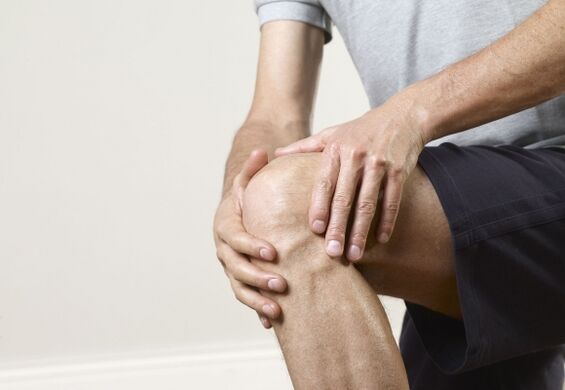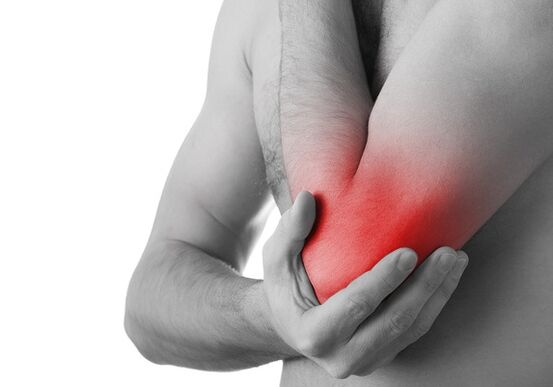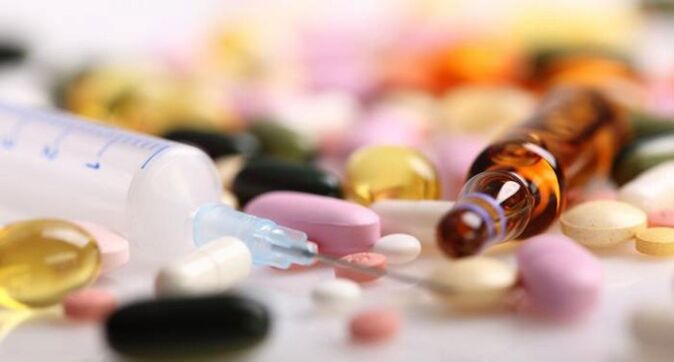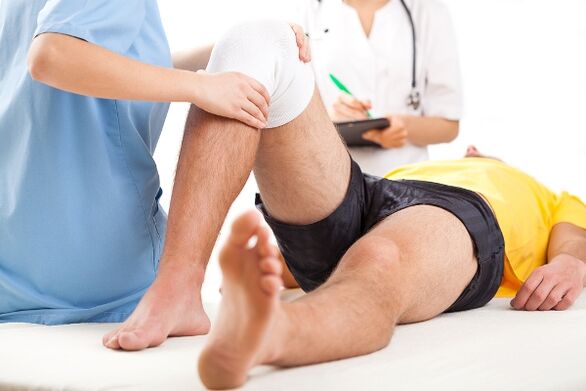Arthrosis is a chronic pathology whose goal is damage to the joint structures of the locomotor system. The main reason that leads to chronic disease is metabolic imbalance, which leads to a progressive process of a degenerative-dystrophic nature. The targets of the harmful reaction are articular cartilage, connective tissue, bursae, tendons, bones and muscle corset. In the chronic form of the pathology, the periarticular muscles are involved in the inflammatory process, they lose their anatomical elasticity due to joint deformation and swelling. In order to eliminate the complications associated with blocking the biomotility of the skeleton, and not become disabled, you need to arm yourself with information about arthrosis - what it is, what are its causes, symptoms and treatment.

Causes and risk factors for the development of pathology
The inflammatory-destructive process in the joints often starts for no reason. Idiopathic (primary) arthrosis has this beginning. The mechanism of development of secondary arthrosis begins after certain conditions and factors, namely:
- Joint injury (fracture, meniscus damage, ligament rupture, dislocation, compression + bruise, bone fracture).
- Dysplasia (abnormal intrauterine development of joint components).
- Violation of material metabolism.
- Autoimmune-type pathologies (rheumatoid arthritis, psoriasis, autoimmune toxic goiter, systemic lupus erythematosus).
- Nonspecific destructive arthritis (with purulent component).
- Infections of various etiologies (tuberculosis, meningitis, encephalitis, gonorrhea, syphilis, hepatitis).
- Endocrine gland pathologies (diabetes mellitus, toxic goiter, adrenal and pituitary gland pathology).
- Hormonal dysfunction (decrease in estrogen, androgen levels).
- Degenerative + dystrophic reactions (multiple sclerosis, Perthes disease).
- Oncological diseases.
- Blood diseases (hemophilia, anemia, leukemia).
Risk factors that provoke and lead to arthrosis:
- Age-related changes.
- Obesity (excessive body weight leads to constant vertical loads, which overload joints, which quickly wear out, lose cartilage plates).
- Professional costs, that is, the load on a certain group of joints, which leads to their inflammation or premature destruction before other groups.
- Postoperative consequences: highly traumatic operations with extirpation of affected tissues (soft, cartilaginous, bone). After restorative manipulations, the joint structure does not have the same consolidation, so any load leads to arthrosis.
- Hereditary factor, i. e. arthrosis can affect one or more family members.
- Hormonal imbalance during menopause or after extirpation of ovaries in women, prostate in men.
- Violation of water and salt balance.
- Neurodystrophic damage to the spinal column is the trigger for glenohumeral, lumbosacral and hip arthritis-arthrosis.
- Poisoning by pesticides, heavy metals.
- Fluctuations in temperature with sudden changes plus hypothermia.
- Permanent trauma to a certain group of joints.
Risk factors include an environment that has recently been saturated with high background radiation, toxic substances (smog over industrial cities and industrial zones, as well as frequent testing of military equipment or interstate wars, resulting in ozone holes + strong ultraviolet radiation). Dirty drinking water + food rich in preservatives lead to the development of arthrosis.
Mechanism of arthrosis development
The basis of the driving mechanism of arthrosis is the interruption of the chain of regeneration of cartilage cells and the correction of affected areas of connective tissue with young cells. Cartilage plates firmly cover the terminal surfaces of bones that are part of the locomotor joints. Normal cartilages anatomically have a strong structure, they are smooth, elastic, and thanks to synovial fluid, which is a biological material for lubricating intra-articular components, they slide. It is the synovial fluid that allows the joint components to move smoothly relative to each other.
Cartilage tissue and synovial lubrication perform the main function of cushioning effect, reducing the abrasion of cartilage-covered bones. The bony ends are separated by sacs of fluid, and a brace of ligaments and muscles firmly stabilizes them. The specific configuration and plexus of the musculo-ligamentous apparatus allows this structure to perform precise biomechanical movements such as flexion, extension, rotation + rotation. The design, thanks to the interlacing of ligaments, allows you to hold firmly in a certain position, as well as to perform coordinated movements, maintaining the balance of the body.
High stress or hormonal imbalances lead to the destruction of collagen plates, exposing the bones. In these areas, pointed osteophytes appear, which cause pain during any movement of the musculoskeletal joints. The bones thicken, and false joints develop between the osteophytes, which completely change the functionality of the movement organs. There is less synovial fluid due to the trauma of the bursa (its rupture), and the entire structure of the joint begins to suffer, together with the corset of ligaments + muscles. Swelling of the joints appears, and a microbial infection may also occur. Ossification zones lead to limited movement and joint ankylosis.
Phases of clinical manifestations of joint pathology: stages
Arthritis is characterized by three stages of development, which consist of:
- Phase I:there are no special morphological changes, trophism is not disturbed, synovial fluid is produced in sufficient quantities. The stability of the joint structure corresponds to average physical activity. Pain and swelling of the joint occurs during forced labor.
- Phase II:depletion of the cartilage plate is observed, foci of osteophytic swellings develop and ossification appears along the edges of the joint. The pain syndrome intensifies, swelling increases and discomfort in movement appears. As the pathology moves into the chronic stage, the pain is constant, followed by inflammation with periods of exacerbation/remission. Biomechanics is partially disturbed, the patient spares the joint.
- Phase III:the cartilaginous plate is completely worn out, instead of cartilage a system of osteophytes develops + falsely fixed interosteophytic joints at the ends of the bones. The anatomical shape is completely disturbed. Joint ligaments and muscles are shortened and thickened. The slightest injury can cause dislocations, fractures and cracks. The trophism of the locomotor organs is damaged, so they do not receive the necessary amount of blood and nutrients. Pinched nerves lead to a severe pain reaction, which disappears only after the use of strong painkillers or drugs from the COX1/COX2 group.
Another stage can usually be added: the fourth - the final stage with a vivid clinical picture of inflammation, infection, unbearable pain, immobilization of diseased joints, high temperature and severe condition. This stage is the most difficult, which can lead to sepsis and death.
Pain syndrome of arthrosis
Pain is characteristic of arthrosis. They are intensified by movement, physical activity, changes in weather conditions, changes in temperature, humidity level and atmospheric pressure. Pain can be caused by any position of the body or sudden movements. Walking, running and standing vertically for a long time put a certain load on the painful joints, after which acute or aching pain begins. In the first and second stages of the pathology, the pain syndrome disappears without a trace after a night's rest, but in the advanced stage the pain is constant and does not disappear. The affected shock-absorbing layer, pinched nerves and blood vessels lead to stagnant processes with impaired trophism and accumulation of interstitial fluid. The swelling causes acute throbbing pain.

Specific for arthrosis is pain after a long rest with a sharp motor impulse; this condition is called incipient pain. The mechanism of development of these pains are osteophyte zones covered with destructive remnants of cartilage tissue, fibrin and viscous fluid. When the joints are moved, a film of these components or detritus covers the exposed areas, lubricating them and thus absorbing the pain. Blockade pain occurs after destruction products from the intra-articular space, i. e. bone remains or a large film of connective tissue, enter the muscles. There is another type of pain: constant, painful, shooting + independent of movements, they are characteristic of reactive synovitis.
Attention!Blockade type of pain is subject only to surgical intervention followed by restoration of the affected joint. Treatment with folk remedies is not recommended, it is fraught with the development of purulent arthrosis with the spread of infection throughout the body, and after sepsis there are obvious morphological changes in all organs and systems.
Symptoms of joint inflammation
Symptoms are divided depending on the degree of development of the pathology. Arthrosis is felt after 38-40 years, when the cushioning system of the joints begins to wear out, and no renewed or young cartilage pads appear in its place. With hormonal imbalance, "chaos" occurs in all vital systems, this also applies to the locomotor system, so in the affected areas tissues do not regenerate, but destruction + deformation occurs.
Symptoms of arthrosis:
| Degrees and periods of arthrosis | Description of symptoms |
|---|---|
| I degree |
|
| II degree |
|
| III degree |
|
| Periods of exacerbation and remission | In arthrosis, exacerbations alternate with remissions. The pathology is aggravated by physical activity. Exacerbations are caused by synovitis. The pain syndrome covers all affected areas, including the muscle corset. It spasms reflexively, forming painful contractures. Arthrosis is characterized by muscle spasms. As the destruction increases, the pain syndrome becomes more pronounced. In reactive synovitis, the joint increases in size and takes on a spherical shape. Fluid appears in the joints, which after palpation creates the effect of fluctuation. During a short remission, the pain subsides, but movement is difficult. |
Timely detection of pathology using diagnostic tests and consultation with the necessary specialists will help to pass the second and third stages, maintaining the functionality and health of all joint groups of the locomotor system until old age.
Diagnostic measures
Clarification of the diagnosis is based on laboratory/instrumental studies. Each case is studied differently, i. e. with an individual approach to each patient.
The list of studies consists of:
- General and biochemical blood tests.
- Rheumatoid agent blood test.
- Analysis of urine and feces.
- X-ray examination: image in three positions.
- CT scan of the joint to clarify the bone structure.
- MRI of the joint: study of ligaments and muscles.
- Computed tomography.
Important!Patients with arthrosis need a consultation with an orthopedist, rheumatologist, endocrinologist, hematologist, oncologist, and patients are recommended to consult a gynecologist.
Treatment regimen
Therapeutic tactics include a whole series of measures aimed at removing the main cause, correcting the nutritional diet, restoring the lost function + gentle lifestyle, i. e. without special physical activity (long walks, running, carrying heavy objects). The therapeutic treatment regimen consists of drug therapy, local treatment, physiotherapeutic procedures and exercise therapy. In parallel with these methods, folk remedies are also used.

Drug therapy for arthrosis
Complex therapy consists of:
- Medicines of the NSAID group;
- Painkillers (tablets + injections);
- Medicines that relieve muscle spasms (muscle relaxants);
- Means for restoring cartilage tissue (chondroprotectors);
- Antibiotics;
- Antihistamines;
- Medicines that improve blood circulation;
- Vitamins: B2, B12, PP and A;
- Antioxidants: vitamin C;
- Medicines based on hormonal substances.
It is recommended to include in the treatment regimen of rheumatoid arthritis:
- Medicines based on gold;
- Immunosuppressants;
- Antimalarial drugs;
- Medicines that inhibit malignant cells.
Attention!During the remission of the pathology, non-steroidal anti-inflammatory drugs are not recommended, they affect the gastrointestinal tract, causing numerous ulcers, and also inhibit the process of cartilage tissue nutrition.
Ointments for local use for arthrosis
Local treatment has a direct effect. Gels and ointments come directly into contact with the affected tissue, quickly reach the site, eliminating pain and inflammation. Preparations in the form of gel are widely used to restore the cartilage layer. For local application, warming + anti-inflammatory ointments are used.
Physiotherapy
Alleviation of colic pain with reduction of inflammation + improvement of trophism and innervation is carried out with the help of physiotherapy. Exacerbation phases are eliminated or shortened by laser therapy, magnetic fields and ultraviolet radiation. In the remission phase of arthrosis, i. e. during the resting phase, electrophoresis procedures using dimethyl sulfoxide and anesthetics are useful. Destructive and inflammatory processes are affected by phonophoresis with glucocorticosteroids, inductothermy, thermal applications of ozokerite or paraffin, as well as sulphide, radon and sea baths. The muscle corset is strengthened by electrical stimulation.

Operation
The problem of a deformed/ankylosed joint is finally solved by surgical operations such as endoprosthetics, as well as a palliative method of relieving the joint frame (coxarthrosis is eliminated by transtrochanteric osteotomy + femoral fascia fenestration; gonarthrosis is corrected by arthrotomy with cleaning of the intra-articular space from the remains of destruction plus artificial cartilage enlargement). If the bone is completely disabled, it is replaced with an artificial graft, and the axis of the tibia is corrected.
Folk remedies
Traditional medicine helps to get rid of pain and inflammation, temporarily relieves pain and restores lost function. There are isolated cases of complete healing by traditional methods using the following tinctures, ointments and poultices:
- Tincture of garlic + onion and honey: 100 g of garlic pulp + 100 g of chopped onion + 2 large spoons of honey + 200 ml of vodka. Infuse for 3-5 days. Apply in the form of poultices and rubs.
- Sabelnik in the form of a tincture: 200 g of dry powder or fresh pulp + 200 ml of diluted medical alcohol, leave for 24 hours. Drink a spoonful before meals 3 times a day.
- Ointment based on badger fat and propolis: rub into the joints, apply twice a day.
- Table horseradish + honey: 100 g horseradish + 100 g honey + 100 ml vodka. Infuse for 24 hours, drink 20 drops. This tincture can be rubbed on painful joints 3-5 times a day.
- Hot pepper fat + lard: 1 teaspoon of powder + 200 g of fat. Infuse for 2-3 days. It is used as a local warming remedy. Apply 1-2 per day.
- Compress: oak bark + spruce needles: 200 g of oak bark + 200 g of crushed spruce needles + 100 ml of alcohol.
We recommend using all the listed recipes of folk healers only after consulting a doctor. If the patient is allergic to certain drugs, their use is strictly prohibited, as they can lead to anaphylactic shock.
Characteristics of prevention
Prevention is an effective means of preventing disease, destruction and deformation of joints. For preventive purposes, you must do the following:
- Adjust the menu, from which exclude fried, fatty, peppery, salty, alcohol + nicotine.
- Add jellies and jellies to your daily menu.
- Avoid fatiguing loads.
- Increase safety measures to avoid injury.
- Constantly perform a special set of exercises for the locomotor system.
- Try taking vitamins B and C.
- For preventive purposes, take chondroprotectors, calcium, potassium and other mineral supplements once every six months.
- After a sprained joint or mechanical injury, you should be examined by a doctor.
The list is joined by performing constant physical exercises to improve blood supply, innervation and renewal of the cartilage layer of the joints. These exercises are prescribed by a doctor.
Summary
Destruction with joint deformation begins after 38-40 years, so there is no need to delay the fight against this pathology. A neglected condition can lead to a wheelchair, and a timely response to the disease with effective treatment is a clear success towards recovery. It is impossible to treat arthrosis independently, this type of pathology refers to metabolic disorders that are directly related to changes in hormonal levels or chronic pathologies of other systems. At the first symptoms, consult a traumatologist or surgeon, do not delay, otherwise you will be treated only in the surgical department with long rehabilitation.































